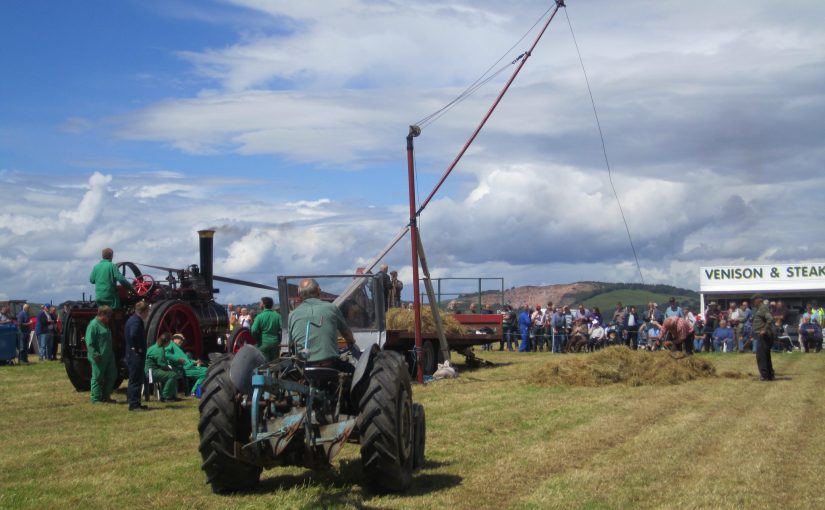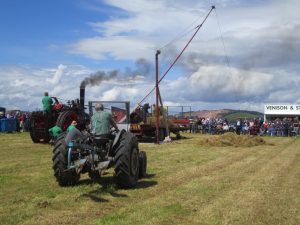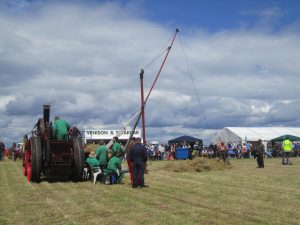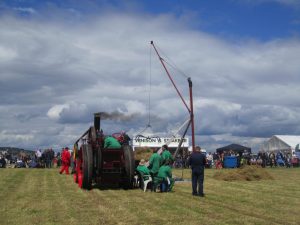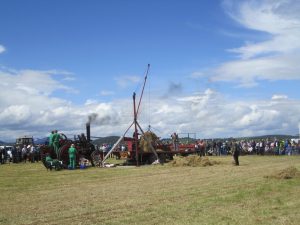In the 1880s and 1890s there were a number of new developments in hay making machinery that were to have a profound impact on the hayfield for many decades to come. One of these was the horse fork, an implement that came from America and was widely adopted in Scotland in a very short time.
The introduction and early use of the hay fork were described at length in the North British Agriculturist, the national agricultural newspaper, in its issue of 4 May 1887 and again in an issue of 3 July 1889. The articles have been quoted at length:
“New machinery in hay making
The horse fork
In America, the horse-fork is an implement in general use on every farm be it large or small, while in Britain, or on the Continen, it is only in very isolated cases that its use has been resorted to. The apathy of European farmers regarding the use of this invention I can only account for by their want of knowledge regarding it, as our farmers, I would fancy, have a larger proportion of hay to stack in either ricks or sheds than what they have, and a more fickle climate to do it is. Hay from the same class of plants will be much the same in both countries, the principal difference of the two countries being the greater scarcity of labour in America than here, which accounts for their having adopted machinery in agricultural operations to a much greater extent than has been done here. Their lighter crops and drier climate make this easier for them than for us, and in nothing is it more clearly shown than in the use of the harvester and binder, as machines which work well with them are unable to deal with the heavy, tangled, and damper crops of the British Isles. With made hay there is, however, no such difference, in fact, its use is more called for, and it will first be introduced where heavy crops have to be dealt with. From what I had learned of horse-forks generally, I felt fairly certain they might with advantage be introduced here also; and with that end in view I year ago instituted inquiries regarding the different persons who had attempted their sale or msnufacture in this country. These I found were few, and all used very much the same class of hoisting gear, viz a pole and gib, or gall, with a rope passing from the fork over the gaff and down the pole. All up to this year used the old pattern of fork, which is very much like a large dung grape of the old malleable iron pattern common about twenty or twenty-five years ago. My idea was that by combining the use of the rick-lifter with the horse-fork. I should effect a greater saving than by the use of either separately; and to put this to the test, I bought two rick-lifters and a set of hoisting gear and grapple fork. For building hay in open ricks or stacks, the methods of raising the hay by a rope on a pole and gib I consider superior to any other yet introduced. The pole may be any length up to 36 feet long, and in two halves, joined together by a short tube of ¼ inch iron, after the style of joining the different parts of a fishing-rod. The gib or gaff is 9 feet long, thereby permitting the hay to be raised to the height of the pole and to be dropped from 7 to 8 feet from the side of the rick. Arrangements are made for lowering the gaff or raising it as is required, while the rick is being built, thereby making it handier to work, and causing less strain on the pole. The pole need not necessarily be in two pieces, but by making it so, a longer, straighter, sounder, and stronger pole can be had than if one tree only is used; while by being in two, it is easier stowed away in some suitable place when not in use. Previous to erection, a hole is dug one spit deep, and from 1 ½ feet to 2 feet from the side of the rick to be built. Into this hole the butt-end of the pole is put, the hole being intended to hold the pole against the pull of the horse when raising the load of hay. To a ring encircling the top of the pole four galvanised strang wires are fixed, which act as guy ropes in keeping it upright. These are tied to large pins driven into the ground at a considerable distance off, thoroughly steadying the pole in any desired position without putting any very great strain on them. The pole is a little difficult to raise on end at first, but when once up it need not be taken down again until the season’s work is past, unless to build some other ricks at some other place on the farm. By thrusting an iron rod, 1 ½ inch or so in diameter, through the pole above the pulley on a level with the horse, two men may easily lift it in their hands or on their shoulders, and by slackening one guy rope and tightening up the one opposite, the two men can freely carry it in a line with these two ropes. A few minutes thus suffice to carry it from one rick which has been finished to another one newly begun. The rope from the fork passes over a pulley on the point of the gib or gaff, down the upper side of it to another pulley, where the gaff joins the pole, then down one side of the pole and under another pulley placed in the centre of the pole about 3 feet above the ground, where the horse is yoked to it. All the patterns of grapple forks work on much the same principle, viz that of a pair of mason’s or quarry shears, only instead of having but one prong or tine in each side as quarry shears have, the hay fork has two or three like the American patterns. Loaded or unloaded, all are opened by pulling a cord which hangs from it for that purpose. The fork when descending is pulled on to the loaded cart or hay rick (field rick) by this cord, and at the same time is kept open by it, so that when allowed to drop on the hay the prongs take more or less of a catch, according to the force with which it is allowed to drop, so that as soon as the horse commences to again raise it the prongs feed themselves, and lift a greater or less quantity according to the grip they had at first, and the looseness or solidity of the hay. The most regular-sized loads are sent up by dropping the fork gently, and pressing in the prongs more or less with the hand, without doing which the one fork load is by far too large, while the next may be only half full. The pole is always erected with a slight lean to the rick, so that when the load is raised above its level, the gib or gaff of its own accord immediately swings round above the rick, when the attendant discharges the load by pulling the cord. The load is thus dropped in the centre of the rick or at either side as is required, so that the rick is regularly consolidated all round, and not unduly pressed down on one side as invariably happens where the forking is done by hand. A horse can easily raise from 2 cwt to 2 ½ cwt, the time occupied being of course regulated by the height to which it is raised. Unknown to the man working the fork I have repeatedly counted the number of times he required to load his fork to raise a rick which had been previously weighed, and in ordinary working I generally found these to average about 1 ¾ cwt. When forking a rick deposited by the rick-lifter as much as 3 cwt I would think would sometimes be raised, that I considered, however, too heavy, and a strain not only on the horse, but on the whole tackle. The horse was all along led by a girl, it moving straight out in any direction which at the time was free of obstruction. In lowering, the horse was always backed not turned, as being the speedier of the two methods. Most grapple forks relieve themselves when drawn up against the point of the gaff, if the attendant has not previously done so, which is occasionally an advantage, although at other times a disadvantage. One American grapple fork does not relieve itself in this manner, although one pattern of spear fork can be made to do do. The grapple forks are the most suitable for loose or short hay, while the spear patterns are to be recommended for long tough stuff like Italian or timothy, although they, like the others, are suitable enough for any kind. A great recommendation of them is their simplicity and cheapness. Where hay is brought to the stack-yard or other place of storing by carts or waggons they may be emptied by the fork while standing alongside the rick, or in the case of carts, where horse power is short, they may be emptied and the hay forked off the ground, as a few feet in height is a matter of little consequence where the horse-fork is in use. The greatest advantage, however, accrues where the hay is brought in by the rick-lifter, as here it is not only carted in at very little trouble, but is also forked to any height with very little expenditure og power. When forking on to a rick, the amount of work capable of being done by the horse-fork is limited more by the number of builders than anything else, as where even three or four persons are on the rick they can be covered up in a very short time, if sufficient hay is at hand to go on full speed. With rick-lifters and the horse-fork I found in last year’s working that one-half the people could take in more hay in a day than double their number could by the old method of carts and hand-forking, and that without ever having a heavy lift, much less a lengthened period of continuous heavy work, of which every one was often sick-tired, and which was always a hurry to get through before harvest. Before trial my servants looked on both rick-lifter and horse-fork, with great disfavour, and called them both maggots, now I believe both would be the last machines they would wish turned off the farm.”
“North British Agriculturist, 3 July 1889
Recent improvements in hay-making machinery
By John Speir, Newton Farm, Cambuslang
Horse forks
Since I wrote you in the autumn of 1886 on this matter, very few improvements have been made on these machines, although they have become much more common than they were then. My opinion of them is that they should be on every farm, be it large or small, as with the horse-fork and rick-lifters one man is certainly able to secure as much hay as three or four men could do before. Not only is this the case, but a great part of the work can now be done, by the use of these machines, by boys or indifferent men, whereas formerly the very strongest were required.
As the fork and rick-lifter do best to use together, experience has taught us that the prongs of both the English and American fork were too slender for lifting hay by horse-power out of a solid rick. These forks were designed to lift loose dry hay from the waggon, and required much longer and slenderer prongs than where the hay was solid, as it is in a rick which has stood from two to four weeks. If the prongs of either class of fork were inadvertently put in too deep, they were sure to be bent, or so much hay caught that the horse could not move it. To remedy these defects new forks have been designed, with shorter and stouter prongs, and although stronger, yet lighter, and not near so large, thus making them more useful for working inside a hay shed, so that the same fork may now be used for both shed and stack building.
In connection with this matter a new class of fork, which is in constant use in America, has recently been brought under my notice. It acts in the same way as if you were to lay a grip on the ground on its back, then put a load on the grip; and after putting your foot on the hilt and holding it on the ground, you were to lift the load with your hand by catching it where the prongs meet the handle, raising it on end, and throwing the load over to the other side. In this case the load is raised the height of the handle, but in the machines in use the hay is raised 25 feet with a much shorter handle than 25 feet. By the use of a peculiar horse-rake, gathering from 4 to 6 cwt of hay, which is dropped on the fork, the Americans can thus stack their crop by lifting it off the ground, and yet never touch it by hand or hand-fork until it is on the stack. This same apparatus can also be sued for loading waggons where the hay is not stacked in the field, but drawn to the farm, to be there hoisted by the ordinary horse-fork. It has struck me that this same apparatus would be very useful for gathering and building ensilage stacks in the field where cut, or where the hay was made on the English system, by bringing it direct from the swathe or windrow to the stack, as in such a case it could easily be put on the stack without ever touching it by hand at all.
This brings me to a part of my subject which I should like to see definitely settled within a year or two-viz whether or not hay can be made in Scotland by carting direct from the field, and applying as much pressure to it in the stack as will prevent fermentation to such an extent that the hay will not become brown or even lose its colour. The horse fork and gatherer which I have described here might be of considerable use to us. I hope, therefore, to hear of the system getting a fair trial during the coming years.”
The horse forks were quickly adopted. On 27 December 1897 the Glasgow Herald could write that “the demand for mowers, horse rakes, hay makers’ rick lifters, and horse forks, was quite exceptional, several beating the record on sales made, and many thousands of these machines were made and sold in Great Britain and Ireland.” Makers of them included John Wallace of Glasgow, P. & R. Fleming & Co., Glasgow, and Jack of Maybole, among others.
The photos were taken at the Fife Vintage Rally, June 2014.
